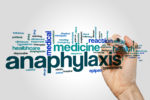 Anaphylaxis is a severe and potentially fatal allergic reaction. It may start within seconds, minutes, or hours following contact with an allergen. An allergen is a substance that is capable of producing an allergic reaction. This happens when the body identifies a substance as harmful and wants to protect itself. Should someone have an anaphylactic reaction, call the Emergency Medical Services immediately.
Anaphylaxis is a severe and potentially fatal allergic reaction. It may start within seconds, minutes, or hours following contact with an allergen. An allergen is a substance that is capable of producing an allergic reaction. This happens when the body identifies a substance as harmful and wants to protect itself. Should someone have an anaphylactic reaction, call the Emergency Medical Services immediately.
A severe anaphylactic reaction is sometimes known as anaphylactic shock. Anaphylaxis can cause the blood pressure to drop quickly, resulting in fainting or even sustained loss of consciousness. It can also cause severe breathing difficulties.
Some common food triggers include:
- Peanuts
- Fish (including shellfish)
- Certain fruits (particularly citrus and kiwifruits)
- Milk
- Eggs
Other triggers of anaphylaxis include:
- Venom from stinging or biting insects and snakes.
- Medicine – most commonly antibiotics, aspirin or ibuprofen
- Latex
Signs and Symptoms
Each persons’ signs and symptoms will be slightly different dependant on what triggers their anaphylaxis and the situation in which the person is in. The most common signs and symptoms of anaphylaxis include:
- Breathing difficulties
- Nausea and Vomiting
- Rashes or Hives appearing on the skin
These are all very easy to identify as well. The patient will be in a lot of distress if they have difficulty breathing. Get them to sit down and lean forward slightly. This takes the strain off of the lungs . You can also ask them if they feel sick. However, tell them before to either give you a thumbs up or down, or nod or shake their head. This puts less pressure on them to speak, especially if they have breathing difficulties. ou should be able to notice any red blotches, rashes or hives on their skin when you arrive at the scene. Sometimes however, they will start to appear later on, so keep an eye out for them.
. You can also ask them if they feel sick. However, tell them before to either give you a thumbs up or down, or nod or shake their head. This puts less pressure on them to speak, especially if they have breathing difficulties. ou should be able to notice any red blotches, rashes or hives on their skin when you arrive at the scene. Sometimes however, they will start to appear later on, so keep an eye out for them.
Other signs and symptoms can include: altered levels of consciousness, hallucinations, excessive sweating and abdominal cramps.
Auto-Injectors
Auto-injectors are the most common route of treatment to aid people who suffer from anaphylaxis. There are 3 types of auto-injector, and these are the EpiPen®, Jext® and Emerade®. Each of these is administered slightly differently, but easy to read instructions are printed on the labels of each. Each individual who suffers from anaphylaxis should have at least one auto-injector. In some cases, one auto-injector will not be enough and therefore it is recommended that a spare one is always kept close by.
It is recommended to inspect auto-injectors frequently as they have an expiry date. Dependant on which auto-injector the person has, they may be able to sign up to a reminder service. This will send them a text reminder before the expiry date arrives so they can order a repeat prescription in time.
Auto-injectors hold a single dose of adrenaline, and should only be used in emergencies.
Learn more about Anaphylaxis and its treatment. Video online training at www.proanaphylaxis.co.uk.


Pingback: Stable angina is a very common problem in the UK